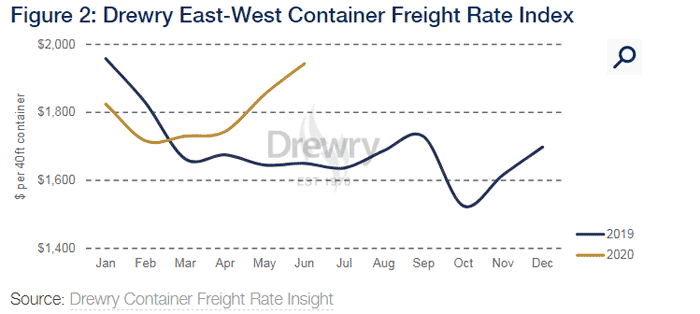Early on in the coronavirus crisis, there were reports ocean container carriers were having a tough time of it, with dozens of sailings out of Asia to the US and Europe being cancelled, a sign of collapsing demand.
Supply Chain Digest Says... |
 |
| Drewry says that without that better collaboration that status quo will continue, characterized by "a sub-optimal supply chain, pockmarked by volatile swings in freight rates and draconian capacity management." |
 |
What do you say? |
| Click here to send us your comments |
| |
| Click here to see reader feedback |
|
|
But while demand has indeed dropped sharply, container carriers have found ways to use that dynamic to find profits, according to the analysts at Drewry, with shipping lines using blanked sailings and idled ships to put for now at least the supply-demand equation back in their favor.
"Perversely, despite a sudden fall off in demand for their services, lines look set this year to make more money than they have in many years as their crisis-management tactics (essentially blanking voyages) have paid off handsomely." Drewry said in its latest Container Insights newsletter.
As seen in the chart below, spot rates for containers are soaring in the face of reduced capacity, and the fact, Drewry says, that carriers are often bumping lower priced contract container moves to later sailings to feast on much higher paying spot boxes.
As a result, "cargo owners have had to contend with greatly inflated transportation costs, but lower service quality," Drewry says.
Drewry also says that despite significantly reduced bunker costs in the second quarter, few shippers saw anything near the full benefit of these reductions, with carriers used their market leverage to hold onto bunker fuel surcharges, using the threat of "rolling" their containers to later sailings.
"From a public relations perspective the optics of making big profits during a global crisis are not great. The price will be more animosity and accusations of profiteering," Drewry writes, though it adds that "Drewry is inclined to give carriers the benefit of the doubt for now."

It notes some container carriers are now starting to return capacity to the lanes hit hardest by capacity reductions, such as Asia to the US east coast, to accommodate higher than expected demand, with some previously blanked sailings being put back on the schedule.
(See More Below
|
CATEGORY SPONSOR: SOFTEON |
|
|
|
|
|
"That makes previous capacity over-reductions look more like understandable misjudgments rather than anything more malicious," Drewry says, but notes "We might change our view if capacity continues to be kept significantly below market needs."
Drewry suggests carriers and shippers need to work more closely to achieve more stability. For example, carriers could do a better job in terms of giving notice and rationale when making capacity changes, while closer consultation with shipprs about the likely timing and scale of any future rebound could help to avoid potential bottlenecks.
It adds that "Cargo owners should be aware that carriers need to maintain a minimum level of revenues in all conditions, or else they will be forced to withdraw services."
Drewry says that without that better collaboration that status quo will continue, characterized by "a sub-optimal supply chain, pockmarked by volatile swings in freight rates and draconian capacity management."
Drewry concludes by noting that "One can but hope that a better shipper/carrier dialogue evolves out of this crisis that might produce more of a happy medium."
SCDigest would not be optimistic on that one.
Any reaction to Drewry's market analysis? Let us know your thoughts at the Feedback section below.
Your Comments/Feedback
|

